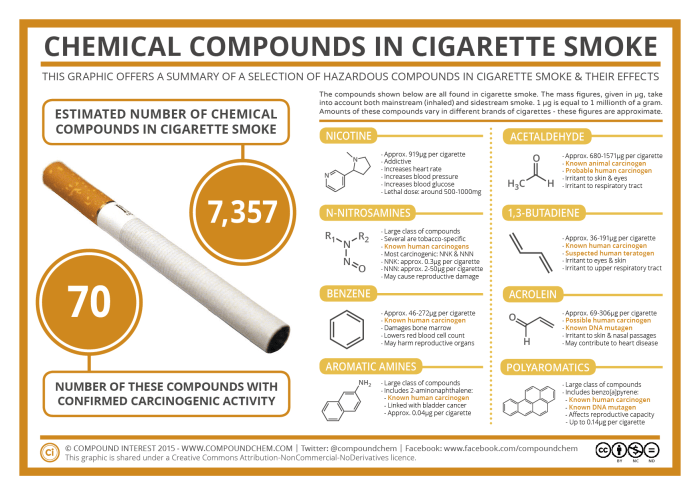
That smoking causes cancer is a well known and scientifically proven fact. Everyone knows that nicotine is present in cigarettes, and causes addiction to smoking; however, what’s a little less well known is the range of chemicals contained within cigarette smoke that can lead to carcinogenic (cancer causing) effects, and what other effects they can have on the body. The effects of some of these chemicals also explain why it’s advised that women shouldn’t smoke during pregnancy.
Cigarette smoke contains a huge number and range of organic compounds. Estimates in the past few years state that there are almost 7360 different compounds present, and it is likely that this number could still increase. Of this massive number of compounds, 70 have confirmed carcinogenic activity in humans, and many more are suspected carcinogens.
Let’s start with an obvious chemical first, however: the non-carcinogenic nicotine. Nicotine is a member of the alkaloid family of compounds, a family of which caffeine is also a member. Cigarettes contain, on average, around 10mg of nicotine; when it is inhaled in cigarette smoke, it is absorbed into the bloodstream, and when it reaches the brain it stimulates the production of a number of neurotransmitters. Nicotine impersonates the neurotransmitter acetylcholine (ACh), and by binding to receptors ACh would usually bind to, stimulates the production of dopamine, which is involved in your body’s ‘reward’ pathways. This leads to the addictiveness of smoking. Nicotine is actually toxic to humans in high doses – much higher than those obtained from smoking cigarettes.
Let’s take a look at some of the other organic compounds in cigarette smoke with more harmful effects:
N-Nitrosamines
These are a large class of nitrogen-containing organic compounds. The majority of nitrosamines that have been studied have been shown to cause DNA mutations, and several are known human carcinogens, including some that are specific to tobacco. Of these, NNK (nicotine-derived nitrosamine ketone) and NNN (nitrosonornicotine) are considered to have the highest risk for carcinogenic action. Research has shown that the amounts of tobacco specific nitrosamines varies widely, and that low tar brands tend to exhibit lower levels of these compounds – though they remain present.
Benzene
Benzene is an organic chemical that is actually formed naturally, as a result of occurrences such as forest fires or volcanic eruptions. However, an important source of human exposure to this compound comes from cigarettes, which are estimated to account for up to 50% of exposure in the USA. Benzene is a proven carcinogen, based on evidence from both animal and human studies. It’s also been shown to cause changes to chromosomes in bone marrow under laboratory conditions. Bone marrow is where new blood cells are made, so damage to this can lead to anaemia, and low levels of other blood constituents.
Industrially, benzene is useful to make ethylbenzene, a precursor to styrene. Styrene can be polymerised to form polystyrene.
Aromatic Amines
Aromatic amines are another family of compounds, often used in the synthesis of pesticides, plastics, and pharmaceuticals. They’re also found in cigarette smoke, with their levels tending to be higher in sidestream smoke (that produced at the lit end of the cigarette). Several of these compounds are confirmed human carcinogens, with increasing evidence that they contribute to bladder cancer in smokers in particular.
Formaldehyde & Acetaldehyde
These two compounds are both members of the aldehyde family of compounds. Formaldehyde is known to be a human carcinogen, whilst acetaldehyde is classified as a confirmed carcinogen in animals and a probable carcinogen in humans. Acetaldehyde is in fact the most abundant carcinogen in tobacco smoke, and dissolves into saliva when smoking. Both acetaldehyde and formaldehyde cause irritation of the skin, eyes, throat, mucus membranes, and respiratory tract.
1,3-Butadiene
1,3-butadiene is a simple hydrocarbon molecule, containing 2 double bonds. In a 2003 study (Fowles & Dybing), the risk factor of various compounds in cigarette smoke for cancer and heart disease was considered, and 1,3-butadiene presented the highest cancer risk by some margin. It’s also a suspected human teratogen (causes deformation of embryos). Studies on animals have shown that breathing butadiene during pregnancy can increase the number of birth defects.
Acrolein
Acrolein is an unsaturated aldehyde (an aldehyde also containing a carbon-carbon double bond). It’s a toxic compound, and an irritant to the eyes, skin, and respiratory tract. Links have been made between acrolein in cigarette smoke and the development of lung cancers, though no there is no current scientific evidence that it is a carcinogen in humans. However, it is a known DNA mutagen, and this in turn could lead to carcinogenic effects. Acrolein has also been been linked with heart disease as a contributor, and is one of the most abundant chemicals in cigarette smoke.
Polyaromatic Hydrocarbons
Polyaromatic hydrocarbons are a group of over 100 different organic chemicals formed by incomplete combustion of organic compounds. Several have been identified are carcinogenic, mutagenic, or teratogenic. Benzo-a-pyrene is one of the most potent, and notably was the first chemical carcinogen to be isolated. High exposure to polyaromatic hydrocarbons in the womb has been associated with lower IQ and childhood asthma, as well as adverse post-birth effects including heart malformations and DNA damage.
![]()
The graphic in this article is licensed under a Creative Commons Attribution-NonCommercial-NoDerivatives 4.0 International License. See the site’s content usage guidelines.
References & Further Reading
- ‘The Chemical Constituents in Cigarettes & Cigarette Smoke’ – J Fowles et al
- ‘The Chemistry & Toxicology of Cigarette Smoke’ – US Department of Health & Human Services
- Student Guide to Chemicals in Cigarette Smoke – SBCTC
- ‘Application of Toxicological Risk Assessment to the Chemical Constituents of Cigarette Smoke’ – J Fowles, E Dybing.






11 Comments
Comments are closed.